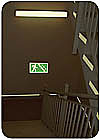
In the post-9/11 world, “life safety†is the new standard being embraced by government officials and leaders in the real estate and construction industries throughout New York City. Rigorous new standards have been approved and adopted for protecting building occupants and guaranteeing a safe exit in the event of a major disruption or disaster.
The forward-looking investments in safety features being made at 7 World Trade Center, the first lower Manhattan tower to be rebuilt since 9/11, include a large concrete core that protects the stairs, an extra stairwell for rescue workers, and improved sprinklers and communications systems.
Additional life safety precautions promulgated in the new building code regulations passed with Local Law 26/04 include a requirement that all owners and property managers of commercial buildings taller than 75 feet install photoluminescent low-level exit path markings (LLEPM) in stairwells and on doors leading to exits.
It has been essential that building managers and owners review and fully comply with the New York City Department of Building’s final technical and performance standards for all installation of photoluminescent markings. Installations were to be completed before July 1, 2006.
Shedding some light
It is important to know that no single photoluminescent product or installation method will perform in every application. The wrong product installed by untested contractors can lead to materials falling off walls, peeling off floors or producing inadequate photoluminescence because of sub-standard installation. This results in not only wasted dollars but potentially unsafe conditions in emergency situations.As the commercial division of the company selected by the Pentagon to be the sole photoluminescent contractor for 9/11 reconstruction, allow us to shed some light on some important things you should consider in completing a successful LLEPM installation that is in compliance with Local Law 26/04. These considerations, of course, are helpful for any LLEPM installation, whether you’re in New York City or not.
- Project management: Installation labor will account for 60-70 percent of the cost of an installation, and will likely determine how long the product lasts. Quality contractors should be able to provide you with a comprehensive plan for how the job will be handled, as well as a fixed price.
- Type of construction: The materials used to construct the stairwell determine the LLEPM product requirements. Different products are right for different environments. For example, cinderblock requires a different method than drywall, which is different than vinyl flooring, which is different than concrete, which is different than sealed concrete.
- Surface preparation: No matter what product you select, surface preparation is essential. Among the factors that need to be considered are cleanliness, profile and compatibility with the adhesive to be used. You don’t want something as simple as a cleaning solution to undermine the time and effort put into your LLEPM solution.
- Product characteristics: Photoluminescent products come in many forms and each has distinct advantages and disadvantages. You will be best served by partnering with an experienced contractor who is knowledgeable and free to select the correct material for your particular applications. A good contractor will know whether a hard plastic product, a more flexible vinyl or even a paint application will not only illuminate best, but hold up to the job at hand.
- Light level: A photoluminescent system requires an appropriate level of ambient lighting to be effective. Both the type of light and the intensity dictate how well any photoluminescent product will perform. There’s a big difference between a hallway with one incandescent bulb, as you might find in older buildings, or several fluorescent lights that keep it bright as day. Buildings whose light systems are triggered by motion sensors have even more to consider.
- Adhesive hazard: Some long-lasting, durable photoluminescent systems are secured with powerful adhesives that can emit volatile organic compounds. These can be a potential health hazard when used in unventilated spaces.
- Contractor reputation: Know how long the contractor has been in business, get referrals, ensure ISO certification and see their quality control process as part of a reputation check-up. Most importantly, be sure to verify the financial stability of the firm you select. You want to be sure they will be able to purchase the product you need and that they will be around to finish the job.
In the end, selecting a qualified contractor with product and engineering expertise as well as a comprehensive approach to project management is the safest and most cost-efficient choice for meeting the “life safety†requirements of Local Law 26/04.